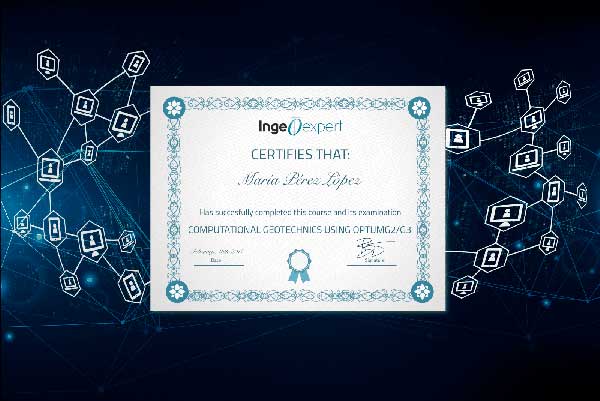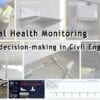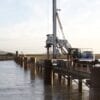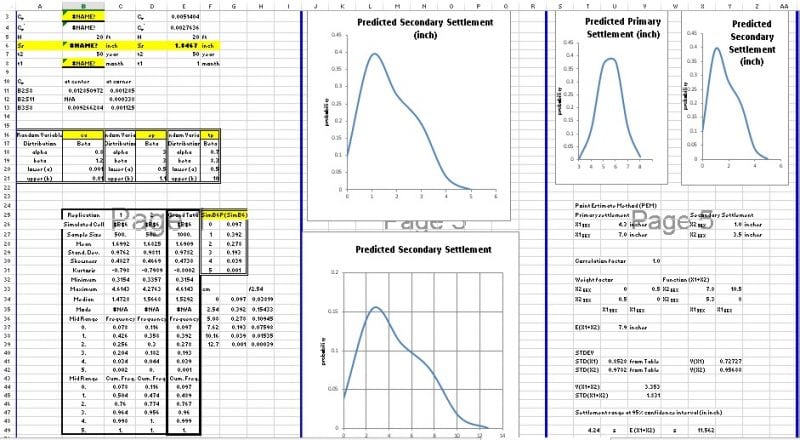Probabilistic Analysis for Geotechnical and Civil Engineering
Online course |
|
50 hours / 6 weeks |
|
|
Dates: 15th of July to 26th of August |
| Standard | Unemployed Or Student |
| $356 | $270 |
Introduction
This online course is intended for senior level undergraduate/graduate students with intermediate civil and geotechnical experiences who also want to apply best available probabilistic/stochastic analysis tools to real geotechnical/environmental/civil engineering problems. This course work will cover principles and basics of probabilistic/ stochastic analysis methods and its applications for shallow foundation/retaining wall/soil&GW remediation designs, statistical evaluation of engineering properties of soil/rock, guidance to best available geotechnical/civil filter design with soil and filter properties, and practical exercise problem sets from actual author’s project experiences. Geotechnical /civil engineer should be trained to cope with non-uniform and heterogeneous soil/rock properties and able to effectively characterize the site ground condition with stochastic parameters to recommend best reliable design for the crucial infrastructures (retaining wall, earth dam/levee & vibration susceptible building) and contaminated soil/groundwater site remediation. Dr. Lee is willing to share his professional experiences to let audience transit a conventional geotechnical/civil practice to a further sophisticate probabilistic/stochastic approach. During the exercise problem, author’s engineering calculation spreadsheets will be provided to audiences to help understand and develop the probabilistic solutions for retaining wall/filter/slab foundation analysis.
Objectives
- Clarify understanding of probabilistic approach in geotechnical/environmental/civil design
- Refresh basics of probability analysis and its application to real project problems
- Acquisition of best available probability methods to identify and diagnose the risk problems.
- Capable to prepare a dam core/filter design report using risk evaluation analysis
- Analytical engineering tools to be provided to audience for retaining wall stability/settlement/filter analysis (Excel programs in either Imperial or SI units) during course exercises
Limited places.
Module I: Basics of Statistics/Probability Analysis (1st week) – Refresher “Essentials of probabilistic analysis”)
– Concept of Reliability Analysis (LRFD vs ASD/LFD)
– Expectation, variance, covariance, probability (density) function
– 1st, 2nd and 3rd moments and its meanings
– Representative data distributions (normal, log-normal, Poisson, uniform, bath-tub & beta)
– Uni-variate probability system (expectation, variance)
– Bi-variate probability system (joint probability analysis)
– Basic statistical analyses (T-test, ANOVA, Correlation, PCA)
– Point estimate method for multi-variate probability system
– Marcov Chain
Quiz I (multiple choice)
Module II: Probabilistic Methods for Site Remediation Analysis (2nd week)
Preloading Design using Probabilistic Methods
– Settlement analysis using field data (boring logs and settlement plates)
– Field/Lab investigation Plan
– Settlement curve analysis (Hyperbolic regression) with settlement plate data
– Theory of Terzaghi 1-D consolidation and its application
– Estimate of compressible soil thickness using joint uniform/Gaussian distributions
Exercise II
Webinar I (2 hours Q/A session for Modules I and II on Friday of 2nd week module)
Module III Probabilistic Methods for Tracing Contaminated GW Plume (3rd week)
Moment Analysis for Natural Attenuation Monitoring using Existing/Proposed Wells.
Background knowledge of GW/soil contamination
Governing Equation of Point Source Contamination Dispersion Behaviors
– 1st Moment Application
– 2nd Moment Application
– 3rd Moment Application
Exemplary Simulation Outputs
Exercise III
Module IV Probabilistic Methods for Foundation Analysis(4th week)
Geotechnical Analysis using Monte Carlo method
– Field/Lab investigation Plan
– External stability check of retaining walls (overturning/sliding/bearing/global)
– Beta distribution and its parameters
– Settlement calculation using Monte Carlo method
– Factor of Safety against Sliding using Monte Carlo method
Exercise IV
Webinar II (2 hours Q/A session for Module III and IV on Friday of 4th week module)
Module V Probabilistic Methods for Geotextile Filter Design(5th week)
Geotextile Filter Design using Probabilistic Constriction and Clogging Models
– Constriction size vs. opening size
– Geotextile engineering features (input parameters for filter design)
– Poissonian polyhedral model for constriction size distribution
– Comparison to Giroud model
– Physical vs. physicochemical clogging
– Marcov Chain application
Exercise V
Module VI Probabilistic Methods for Granular Filter Design(6th week)
Granular Filter Design using Probabilistic Constriction Model
– Particle size distribution vs. relative density considered in filter design
– Base soil/granular filter engineering features (input parameters for filter design)
– Probabilistic model for constriction size distribution
– Comparison to Kenney and Lau model
– Filter design in view of retention and drainage
– Renormalization process
Exercise VI
Webinar III (2 hours Q/A session for modules V and VI, Friday of 6th week)
Final Test (1 hour for multiple choices, deadline by a week after Webinar III)
Grading Method for Certificate
40% – Exercise Assignments
60% – Final Exam
Spreadsheet programs to be provided during class
-Analytical tool for Factor of Safety against sliding & settlements
-Analytical tool for Joint uniform/Gaussian distribution
-Analytical tool for Moment analysis tool to predict a GW plume direction and dispersion rate
-Analytical tool for Geotextile filter design
-Analytical tool for Granular filter design
Dr. Lee
Lecturer, Dr. Lee has over 15 years professional experiences of civil/ environmental /geotechnical industries and having published 12 technical papers at international peer review journal and conferences after Ph.D. graduation from Purdue University. He had worked for many city, state and federal projects and drafted and reviewed project documents/drawings including construction plans and engineering calculations for bridge/retaining wall structures, grading and right of way aspects to check conformance with construction codes, regulations and engineering standards of practice such as AASHTO, FHWA, DOT manuals and U.S. State specifications.
He has developed geotechnical laboratory test manuals and managed Army Corp /AMRL /ASTM certified laboratory over 10 years. Also participated in several kick-off and on-site meetings for complex civil and/or geotechnical engineering features of development plans including embankment and slope analysis (Wisconsin, Iowa, Minnesota, Washington DOT); seepage analysis for flood wall design (Chicago and Jacksonville headquarters of USACE), earthquake and erosion hazards for levee/earth dam (FEM and probabilistic methods); deep foundations (driven pipe/H piles, drilled shaft for Wisconsin, Iowa, Minnesota, Illinois, Washington DOTs); retaining walls (MSE, CIP, and modular block walls); excavation shoring (cantilever and anchor system).
Dr. Lee considers himself within top 1% geotechnical engineer, familiar with advanced engineering design and innovative analysis methods (probabilistic/stochastic methods including LRFD) and having made discrete engineering judgments over many complex and interdisciplinary civil projects.
The course is delivered online through our easy-to-use Virtual Campus platform. For this course, a variety of content is provided including:
– eLearning materials
– Videos
– Interactive multimedia content
– Live webinar classes
– Texts and technical articles
– Case studies
– Assignments and evaluation exercises
Students can delivery the materials and work through the course at their own pace.
We regularly update this course to ensure the latest news and state-of-the-art developments are covered, and your knowledge of the subject is current.
Live webinars form part of our course delivery. These allow students and tutors to go through the course materials, exchange ideas and knowledge, and solve problems together in a virtual classroom setting. Students can also make use of the platform’s forum, a meeting point to interact with tutors and other students.
The tutoring system is managed by email. Students can email the tutor with any questions about the course and the tutor will be happy to help.
– Undergraduates above senior level or graduate level who are interested in learning advanced probability analyses.
– Engineers who wants pursuing or transitioning to a geotech/civil engineer career path in future
– Geotech engineers who want to be more competent with probabilistic approach
– Civil engineers who are involved in federal/local government project to renovate old dam/levee.
– Structure/architectural engineers who want to learn how to evaluate risk evaluation of foundation
Once a student finishes the course and successfully completes the assignments and evaluation tests, they are sent an accreditation certificate. The certificate is issued by Ingeoexpert to verify that the student has passed the course. It is a digital certificate that is unique and tamper-proof – it is protected by Blockchain technology. This means it is possible for anyone to check that it is an authentic, original document.
You will be able to download the certificate in an electronic format from the Virtual Campus platform. The certificate can be forwarded by email, shared on social networks, and embedded on websites. To see an example, click here.
– Lead civil/geotechnical projects acknowledged as a risk analysis capable engineer
– Check external stability and settlement of retaining wall/slab structure with probabilistic methods
– Environmental risk management of groundwater natural attenuation sites
– Participate in government projects (State or federal funded) employing risk control/management.
– Learn more reliable and sophisticated GT and granular filter design using a probabilistic approach.
– Verify your outputs from commercial probability software (black boxed) with analytical tools of first principle
Introduction
This online course is intended for senior level undergraduate/graduate students with intermediate civil and geotechnical experiences who also want to apply best available probabilistic/stochastic analysis tools to real geotechnical/environmental/civil engineering problems. This course work will cover principles and basics of probabilistic/ stochastic analysis methods and its applications for shallow foundation/retaining wall/soil&GW remediation designs, statistical evaluation of engineering properties of soil/rock, guidance to best available geotechnical/civil filter design with soil and filter properties, and practical exercise problem sets from actual author’s project experiences. Geotechnical /civil engineer should be trained to cope with non-uniform and heterogeneous soil/rock properties and able to effectively characterize the site ground condition with stochastic parameters to recommend best reliable design for the crucial infrastructures (retaining wall, earth dam/levee & vibration susceptible building) and contaminated soil/groundwater site remediation. Dr. Lee is willing to share his professional experiences to let audience transit a conventional geotechnical/civil practice to a further sophisticate probabilistic/stochastic approach. During the exercise problem, author’s engineering calculation spreadsheets will be provided to audiences to help understand and develop the probabilistic solutions for retaining wall/filter/slab foundation analysis.
Objectives
- Clarify understanding of probabilistic approach in geotechnical/environmental/civil design
- Refresh basics of probability analysis and its application to real project problems
- Acquisition of best available probability methods to identify and diagnose the risk problems.
- Capable to prepare a dam core/filter design report using risk evaluation analysis
- Analytical engineering tools to be provided to audience for retaining wall stability/settlement/filter analysis (Excel programs in either Imperial or SI units) during course exercises
Limited places.
Module I: Basics of Statistics/Probability Analysis (1st week) – Refresher “Essentials of probabilistic analysis”)
– Concept of Reliability Analysis (LRFD vs ASD/LFD)
– Expectation, variance, covariance, probability (density) function
– 1st, 2nd and 3rd moments and its meanings
– Representative data distributions (normal, log-normal, Poisson, uniform, bath-tub & beta)
– Uni-variate probability system (expectation, variance)
– Bi-variate probability system (joint probability analysis)
– Basic statistical analyses (T-test, ANOVA, Correlation, PCA)
– Point estimate method for multi-variate probability system
– Marcov Chain
Quiz I (multiple choice)
Module II: Probabilistic Methods for Site Remediation Analysis (2nd week)
Preloading Design using Probabilistic Methods
– Settlement analysis using field data (boring logs and settlement plates)
– Field/Lab investigation Plan
– Settlement curve analysis (Hyperbolic regression) with settlement plate data
– Theory of Terzaghi 1-D consolidation and its application
– Estimate of compressible soil thickness using joint uniform/Gaussian distributions
Exercise II
Webinar I (2 hours Q/A session for Modules I and II on Friday of 2nd week module)
Module III Probabilistic Methods for Tracing Contaminated GW Plume (3rd week)
Moment Analysis for Natural Attenuation Monitoring using Existing/Proposed Wells.
Background knowledge of GW/soil contamination
Governing Equation of Point Source Contamination Dispersion Behaviors
– 1st Moment Application
– 2nd Moment Application
– 3rd Moment Application
Exemplary Simulation Outputs
Exercise III
Module IV Probabilistic Methods for Foundation Analysis(4th week)
Geotechnical Analysis using Monte Carlo method
– Field/Lab investigation Plan
– External stability check of retaining walls (overturning/sliding/bearing/global)
– Beta distribution and its parameters
– Settlement calculation using Monte Carlo method
– Factor of Safety against Sliding using Monte Carlo method
Exercise IV
Webinar II (2 hours Q/A session for Module III and IV on Friday of 4th week module)
Module V Probabilistic Methods for Geotextile Filter Design(5th week)
Geotextile Filter Design using Probabilistic Constriction and Clogging Models
– Constriction size vs. opening size
– Geotextile engineering features (input parameters for filter design)
– Poissonian polyhedral model for constriction size distribution
– Comparison to Giroud model
– Physical vs. physicochemical clogging
– Marcov Chain application
Exercise V
Module VI Probabilistic Methods for Granular Filter Design(6th week)
Granular Filter Design using Probabilistic Constriction Model
– Particle size distribution vs. relative density considered in filter design
– Base soil/granular filter engineering features (input parameters for filter design)
– Probabilistic model for constriction size distribution
– Comparison to Kenney and Lau model
– Filter design in view of retention and drainage
– Renormalization process
Exercise VI
Webinar III (2 hours Q/A session for modules V and VI, Friday of 6th week)
Final Test (1 hour for multiple choices, deadline by a week after Webinar III)
Grading Method for Certificate
40% – Exercise Assignments
60% – Final Exam
Spreadsheet programs to be provided during class
-Analytical tool for Factor of Safety against sliding & settlements
-Analytical tool for Joint uniform/Gaussian distribution
-Analytical tool for Moment analysis tool to predict a GW plume direction and dispersion rate
-Analytical tool for Geotextile filter design
-Analytical tool for Granular filter design
Dr. Lee
Lecturer, Dr. Lee has over 15 years professional experiences of civil/ environmental /geotechnical industries and having published 12 technical papers at international peer review journal and conferences after Ph.D. graduation from Purdue University. He had worked for many city, state and federal projects and drafted and reviewed project documents/drawings including construction plans and engineering calculations for bridge/retaining wall structures, grading and right of way aspects to check conformance with construction codes, regulations and engineering standards of practice such as AASHTO, FHWA, DOT manuals and U.S. State specifications.
He has developed geotechnical laboratory test manuals and managed Army Corp /AMRL /ASTM certified laboratory over 10 years. Also participated in several kick-off and on-site meetings for complex civil and/or geotechnical engineering features of development plans including embankment and slope analysis (Wisconsin, Iowa, Minnesota, Washington DOT); seepage analysis for flood wall design (Chicago and Jacksonville headquarters of USACE), earthquake and erosion hazards for levee/earth dam (FEM and probabilistic methods); deep foundations (driven pipe/H piles, drilled shaft for Wisconsin, Iowa, Minnesota, Illinois, Washington DOTs); retaining walls (MSE, CIP, and modular block walls); excavation shoring (cantilever and anchor system).
Dr. Lee considers himself within top 1% geotechnical engineer, familiar with advanced engineering design and innovative analysis methods (probabilistic/stochastic methods including LRFD) and having made discrete engineering judgments over many complex and interdisciplinary civil projects.
The course is delivered online through our easy-to-use Virtual Campus platform. For this course, a variety of content is provided including:
– eLearning materials
– Videos
– Interactive multimedia content
– Live webinar classes
– Texts and technical articles
– Case studies
– Assignments and evaluation exercises
Students can delivery the materials and work through the course at their own pace.
We regularly update this course to ensure the latest news and state-of-the-art developments are covered, and your knowledge of the subject is current.
Live webinars form part of our course delivery. These allow students and tutors to go through the course materials, exchange ideas and knowledge, and solve problems together in a virtual classroom setting. Students can also make use of the platform’s forum, a meeting point to interact with tutors and other students.
The tutoring system is managed by email. Students can email the tutor with any questions about the course and the tutor will be happy to help.
– Undergraduates above senior level or graduate level who are interested in learning advanced probability analyses.
– Engineers who wants pursuing or transitioning to a geotech/civil engineer career path in future
– Geotech engineers who want to be more competent with probabilistic approach
– Civil engineers who are involved in federal/local government project to renovate old dam/levee.
– Structure/architectural engineers who want to learn how to evaluate risk evaluation of foundation
Once a student finishes the course and successfully completes the assignments and evaluation tests, they are sent an accreditation certificate. The certificate is issued by Ingeoexpert to verify that the student has passed the course. It is a digital certificate that is unique and tamper-proof – it is protected by Blockchain technology. This means it is possible for anyone to check that it is an authentic, original document.
You will be able to download the certificate in an electronic format from the Virtual Campus platform. The certificate can be forwarded by email, shared on social networks, and embedded on websites. To see an example, click here.
– Lead civil/geotechnical projects acknowledged as a risk analysis capable engineer
– Check external stability and settlement of retaining wall/slab structure with probabilistic methods
– Environmental risk management of groundwater natural attenuation sites
– Participate in government projects (State or federal funded) employing risk control/management.
– Learn more reliable and sophisticated GT and granular filter design using a probabilistic approach.
– Verify your outputs from commercial probability software (black boxed) with analytical tools of first principle
2 reviews for Probabilistic Analysis for Geotechnical and Civil Engineering
More info
Finish this course and get a certificate based on Blockchain
Probabilistic Analysis for Geotechnical and Civil Engineering

Blockchain technology makes the certificate incorruptible, enabling companies to verifiy its autenticity.
Probabilistic Analysis for Geotechnical and Civil Engineering
| $356 | $270 | |
| Get more information |





Luis A. Vargas H. –
The course is very interesting and allows a rather different point of view for the student regarding Geotechnical problems. I was able to explored and understand topics that used to be complex for me. The good thing is that now I am able to apply the acquired knowledge to my own case studies. Prof. Lee knows with depth about the subject of Statistics/Probability applied to Geotechnics. I really appreciate his patience to explain in great detail. Any question or doubt regarding the different topics was addressed carefully by Prof. Lee.
Tania Velasquez –
This is a good course and the shared spreadsheets really useful for my work.